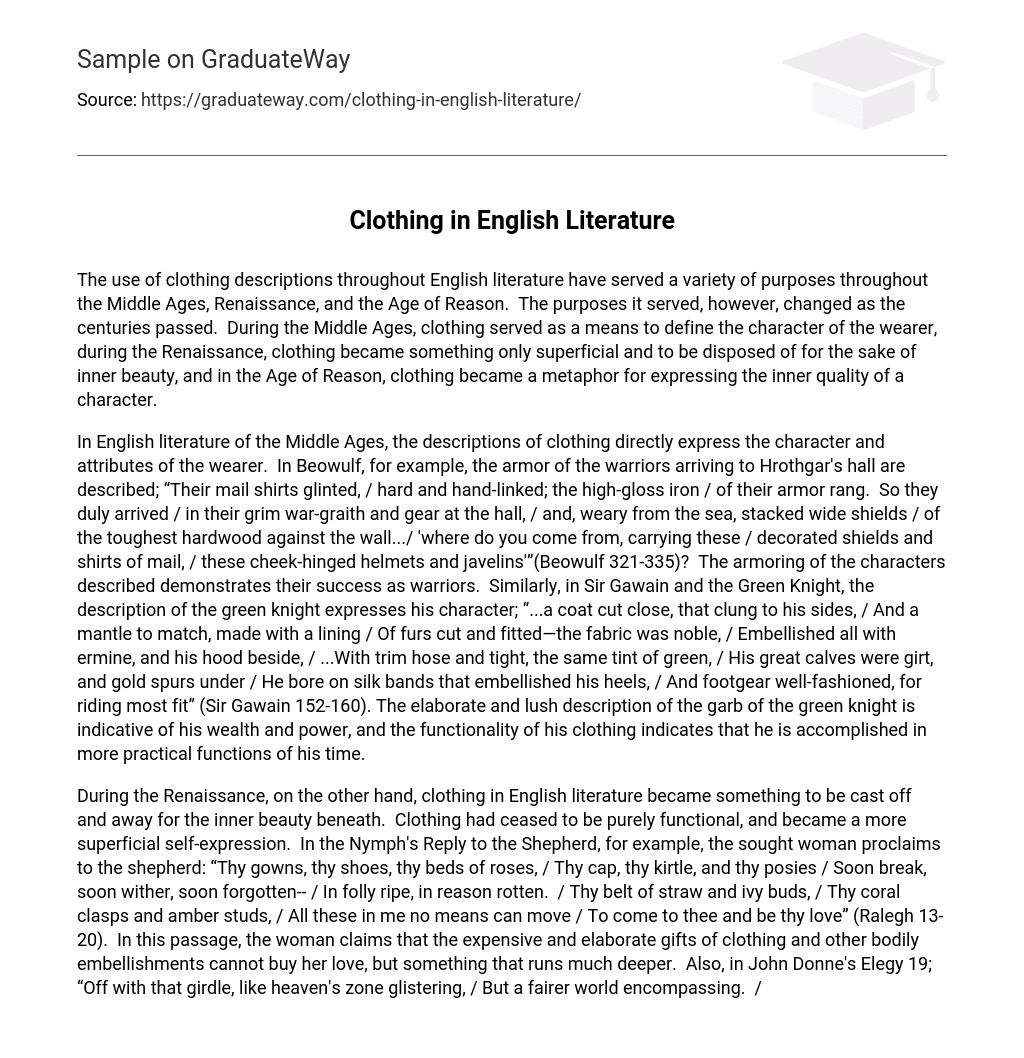The use of clothing descriptions throughout English literature have served a variety of purposes throughout the Middle Ages, Renaissance, and the Age of Reason. The purposes it served, however, changed as the centuries passed. During the Middle Ages, clothing served as a means to define the character of the wearer, during the Renaissance, clothing became something only superficial and to be disposed of for the sake of inner beauty, and in the Age of Reason, clothing became a metaphor for expressing the inner quality of a character.
In English literature of the Middle Ages, the descriptions of clothing directly express the character and attributes of the wearer. In Beowulf, for example, the armor of the warriors arriving to Hrothgar’s hall are described; “Their mail shirts glinted, / hard and hand-linked; the high-gloss iron / of their armor rang. So they duly arrived / in their grim war-graith and gear at the hall, / and, weary from the sea, stacked wide shields / of the toughest hardwood against the wall…/ ‘where do you come from, carrying these / decorated shields and shirts of mail, / these cheek-hinged helmets and javelins’”(Beowulf 321-335)? The armoring of the characters described demonstrates their success as warriors. Similarly, in Sir Gawain and the Green Knight, the description of the green knight expresses his character; “…a coat cut close, that clung to his sides, / And a mantle to match, made with a lining / Of furs cut and fitted—the fabric was noble, / Embellished all with ermine, and his hood beside, / …With trim hose and tight, the same tint of green, / His great calves were girt, and gold spurs under / He bore on silk bands that embellished his heels, / And footgear well-fashioned, for riding most fit” (Sir Gawain 152-160). The elaborate and lush description of the garb of the green knight is indicative of his wealth and power, and the functionality of his clothing indicates that he is accomplished in more practical functions of his time.
During the Renaissance, on the other hand, clothing in English literature became something to be cast off and away for the inner beauty beneath. Clothing had ceased to be purely functional, and became a more superficial self-expression. In the Nymph’s Reply to the Shepherd, for example, the sought woman proclaims to the shepherd: “Thy gowns, thy shoes, thy beds of roses, / Thy cap, thy kirtle, and thy posies / Soon break, soon wither, soon forgotten– / In folly ripe, in reason rotten. / Thy belt of straw and ivy buds, / Thy coral clasps and amber studs, / All these in me no means can move / To come to thee and be thy love” (Ralegh 13-20). In this passage, the woman claims that the expensive and elaborate gifts of clothing and other bodily embellishments cannot buy her love, but something that runs much deeper. Also, in John Donne’s Elegy 19; “Off with that girdle, like heaven’s zone glistering, / But a fairer world encompassing. / Unpin that spangled breastplate which you wear / …Your gown going off, such beauteous state reveals” (Donne 5-14). Here, even more so than in Ralegh’s poem, clothing becomes something to be cast off because it covers up the beauty that lies beneath the clothing.
Finally, during the Age of Reason, clothing becomes almost exclusively metaphorical, revealing the character of the wearer through symbolism, rather than trophies of accomplishment, as in the Middle Ages. In John Milton’s Paradise Lost, for example, one of Satan’s many disguises is described in Book 9: “…thus wrapped in mist / Of midnight vapor glide obscure, and pry / In every bush and brake, where hap may find / The serpent sleeping, in whose mazy folds / To hide me, and the dark intent I bring” (Milton 158-162). In this passage, as Satan hunts for the means to sneak into Paradise to seduce Adam and Eve into sin, is garbed in mist—a metaphor for the ambiguity of his true form, and he searches for the “mazy folds” of a serpent—another metaphor for the twisted and sinister motives he harbors.
Ultimately, the use of clothing in English literature from the Middle Ages to the Age of Reason has come full circle, and at the same time, has evolved into something new. In the Middle Ages, it serves as concrete examples of the triumphs of the wearer—proof of the wearer’s victories and skills, in the Renaissance, clothing is rejected as a representation of the character of an individual, or, the act of rejection of clothing reflects the character of the wearer, but in the Age of Reason, clothing once again becomes a representation of the character of the wearer, but on a metaphorical level, rather than concrete.
Works Cited
- Beowulf. The Norton Anthology of English Literature. Ed. Stephen Greenblatt. 8th ed. Vol. 1. New York: W. W. Norton & Co., 2005. 29-100.
- Donne, John. Elegy 19: To His Mistress Going to Bed. The Norton Anthology of English Literature. Ed. Stephen Greenblatt. 8th ed. Vol. 1. New York: W. W. Norton & Co., 2005. 1283.
- Milton, John. Paradise Lost. The Norton Anthology of English Literature. Ed. Stephen Greenblatt. 8th ed. Vol. 1. New York: W. W. Norton & Co., 2005. 1830-2055.
- Ralegh, Walter. Nymph’s Reply to the Shepherd. The Norton Anthology of English Literature. Ed. Stephen Greenblatt. 8th ed. Vol. 1. New York: W. W. Norton & Co., 2005. 9117-918.
- Sir Gawain and the Green Knight. The Norton Anthology of English Literature. Ed. Stephen
- Greenblatt. 8th ed. Vol. 1. New York: W. W. Norton & Co., 2005. 162-213.





